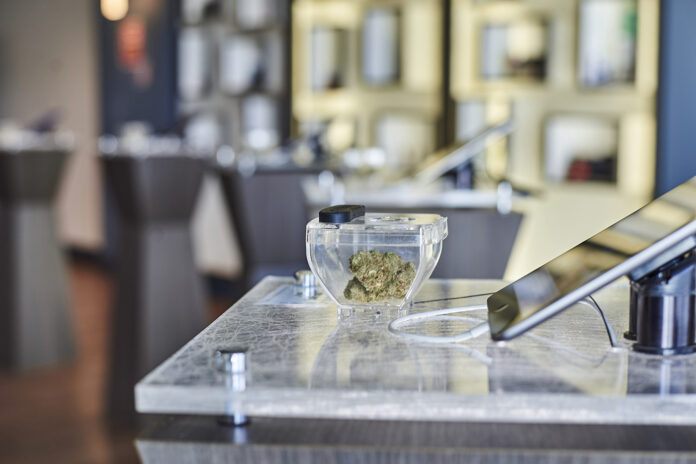As medical cannabis markets expand to include adult use, history shows demand soars. Brands and dispensaries need to move quickly to capitalize on this growth. While new customers enter the market and existing customers see their options broaden, just how much can we expect customer retention dynamics to change? What trends and behaviors should be considered to both acquire and retain customers?
On average, a dispensary in a medical-only state can expect to capture the overwhelming majority of its customers’ trips — almost 80 percent. This could be due to a host of factors including limited number of dispensaries, medical card regulations, or familiarity with dispensary experience and staff.
As we look to adult-use markets, share of trips drops to an average of around 60 percent. This share-of-trip reduction starts gradually as markets mature as opposed to a steep decline. Maturing markets such as Illinois and Massachusetts show less decline — between 70 and 80 percent. In total, the most mature markets in the West capture an average share of 40 to 50 percent of customers’ trips.
Why the decline? Product availability during adult-use launch periods generally is limited to the medical dispensaries that already existed in the market. Legal constraints and retail development timelines may add some delay in new adult-use dispensaries, but that pause won’t last forever. For example, three years after adult-use launch in Illinois, the average minimum distance between dispensaries is approximately seven miles. In California, the average distance is between one and two miles.
Knowing dispensary availability will increase over time, brands and dispensaries can set themselves apart through assortment, pricing, and overall engagement to capture more of each customer’s trips.
Along with an increase in retail options will come an influx of new customers entering adult-use markets. These customers do not necessarily look like medical patients. Some will be dipping a toe in the water, while others will come with extensive knowledge based on experience outside legal markets. Purchasing decisions also will be different. Use this to set your assortment and pricing strategies apart from the competition.
To engage new consumers, consider consumption trends that emerge in an adult-use market. Of course, high-THC products will be in demand for those looking for a potent high. At Hoodie Analytics, we also see a growing trend for sessionable, low-dose products for social consumption. For this trend, ready-to-drink (RTD) beverages have seen an increase in interest and assortment across the United States, with particularly strong distribution growth in Massachusetts, Maine, Illinois, Missouri, and Arizona.
Growth in distribution can occur two ways: expanding the number of dispensaries selling products and adding more items to an existing dispensary menu. We summarize distribution by measuring the total points of distribution, including both the breadth (e.g., the number of dispensaries offering an item for a brand, category, etc.) and depth (e.g., how many brand/category/etc. items are in a dispensary) of distribution.
In the Northeast, RTD beverages’ total points of distribution have grown about 30 percent in the past six months, driven largely by Massachusetts and Maine. Over the same period, Missouri, Arizona, and Illinois RTD beverage distribution grew 54 percent, 18 percent, and 17 percent, respectively. Looking at mature Western markets such as Colorado, California, Washington, and Oregon, an average menu offers about fifteen RTD beverage items. Midwest and Northeast dispensaries offer about five to seven RTD beverage items on average, suggesting room for growth if consumer demand continues and supply chains can support expansion.
Pricing can be a powerful tool to differentiate with consumers. In many markets, cannabis tends to be priced as a commodity, with similar prices across brands. In more mature markets, price stratification is more common. For example, the price range for 3.5g of flower in California or Colorado can be twice that observed in less mature markets like Illinois or Massachusetts. Intentionally set your brand’s strategy in pricing to differentiate it as a value, everyday, or premium product.
Going forward, brands may be able to reach maturity in new adult-use markets at a faster pace than in legacy markets due to increasing cannabis acceptance. This means brands and dispensaries will need to differentiate faster and smarter. By analyzing competitors’ assortments, price points, and store experience, stores in new adult-use markets can better adjust their strategy for differentiation in order to set a solid foundation for their customer relationships. This will help them ensure they are the primary store for their customers’ trips. While those customers may occasionally visit another location for a specific purpose, they will still choose to return to their home store to satisfy the bulk of their cannabis needs.
Understanding what’s available across the country and where customers are shopping provides brands and dispensaries with actionable insights that help them differentiate themselves and capture and retain customers.

Kelly Bernazza-Hall is senior vice president of customer services at Hoodie. The company tracks more than 3.5 million daily unique offers in more than 8,000 dispensaries in the U.S. and Canada, offering next-day insights into metrics such as pricing, promotion, stocking status, distribution, and share of shelf. Previously, she served in senior roles at Big Chalk Analytics, Nielsen, and Cision.










[…] most successful loyalty programs are dynamic and responsive to customer behaviors. Businesses that give their customers personalized attention are more likely to see positive […]